Titian's Venus of Urbino, a masterpiece of ambiguity
When one thinks of the goddesses of beauty that adorn the walls of the Uffizi, the best known is surely Botticelli’s Venus, which has become something of a symbol of the Renaissance itself, but no less important is another apex of Renaissance painting that figures among the works for which one visits the Florentine museum: the Venus of Urbino, a celebrated masterpiece by Titian (Tiziano Vecellio; Pieve di Cadore, c. 1490 - Venice, 1576) executed in 1538, among the best known of the 16th-century Veneto, commissioned by the Duke of Urbino Guidobaldo II della Rovere (Urbino, 1514 - Pesaro, 1574). It was in the small duchy that Giorgio Vasari saw the work, describing it in his Lives as “a young Venus lying with flowers and certain thin cloths around very beautiful and well finished”: this is the first attestation of the painting in literature. The Venus would remain in Urbino until 1631, when the last duke, Francesco Maria della Rovere, died. That year, the rich ducal collection was inherited by Vittoria della Rovere, who had already been betrothed to the Grand Duke of Tuscany, Ferdinando II de’ Medici: the collection was part of her wedding dowry and many of the masterpieces that had once adorned the halls of the Ducal Palace in Urbino took the road to Florence, the reason why they are still found in the museums of the Tuscan capital. We are not sure where the Venus of Urbino was located at the time of its arrival in Florence: perhaps at the Villa Medicea in Poggio Imperiale, due to the fact that it is not identifiable in the inventories of the Uffizi drawn up in 1635 and 1638, and is instead present in those of Poggio Imperiale in 1654-1655. Its entry into the Uffizi must therefore have been towards the end of the seventeenth century.
The first attestation of the painting also dates back to 1538: we find it in a letter written by Guidobaldo II to one of his agents, Girolamo Fantini, in which the duke asks the latter not to leave Venice without taking two paintings with him, namely a portrait of Guidobaldo himself and an unspecified “naked woman,” which has always been unanimously identified by critics with the Venus of Urbino. So, we can imagine that Titian had finished painting her in his studio in Venice that year, and that she was transported from the lagoon city to Urbino territory. The expression “naked woman,” in its apparent triviality, is actually very useful for understanding the reasons for this singular iconographic subject , which, despite its disruptive modernity, is not to be considered Titian’s idea: rather, the Cadore painter had taken up an invention of his master, Giorgione (Giorgio Barbarelli?; Castelfranco Veneto, 1478 - Venice, 1510), who years earlier had painted the famous Sleeping Venus now in the Gemäldegalerie in Dresden, a depiction of the goddess of beauty nude, lying down, caught as she slumbers above a silk veil, against the background of a pleasant country landscape, probably the hills of Asolo, that is, a place familiar to the Venetian patriciate from which the commissioner of this painting came. An image, Giorgione’s, that exalted the concreteness and sensuality of female beauty, probably also on the basis of the link between eroticism and the generative power of amorous sentiment: we can imagine that this painting was commissioned on the occasion of the marriage of the Venetian nobleman Girolamo Marcello, since the first mention of the painting records it in his house. Moreover, for the first time since antiquity, Giorgione’s Venus offered those who were to view it a portrait of a naked and sleeping deity, uncoveredly erotic, as no one else before him had depicted her. An exaltation of earthly beauty that, in fact, established a fashion, gave rise to an iconographictopos and oriented a taste: the Venus of Urbino fits fully into this context, despite the many variations with which Titian updated the iconographic motif.
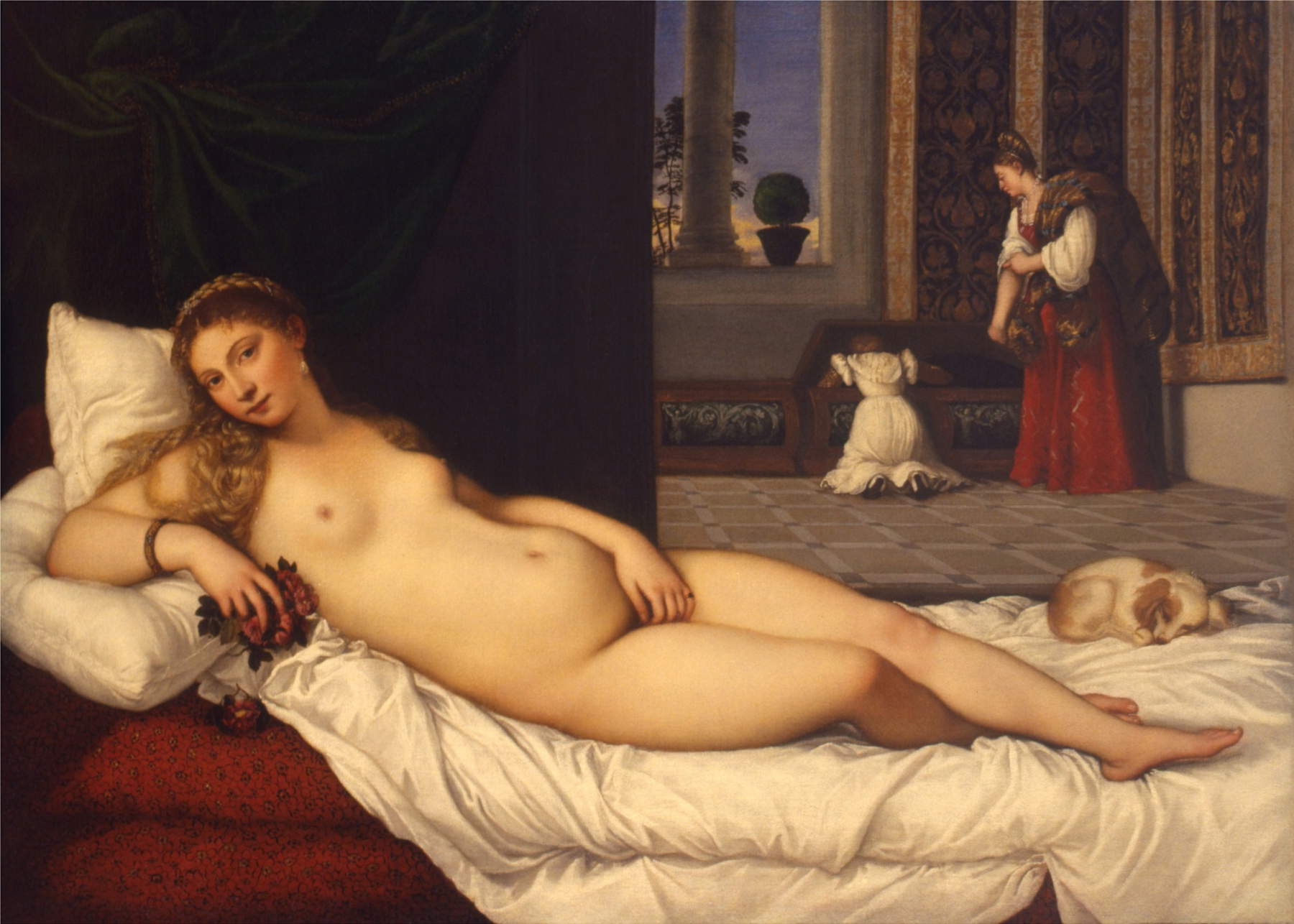
The first difference from Giorgione’s antecedent is the opposite attitude of the Venus: Titian’s goddess, unlike Giorgione’s, is awake and turns her gaze to the viewer, so much so that, according to John Shearman, the painting was made by imagining a specific viewer, and that viewer could be none other than Guidobaldo II himself. The scene is then set in a domestic interior, an expedient that Titian probably had to resort to in order to recreate a setting familiar to his patron, as well as, as art historian Daniel Arasse has suggested, to transform Giorgione’s mythological goddess into a real woman, lying inside a room similar to those of the nobility of the time. Venus is lying on a bed, completely naked. Her blond hair falls over her shoulders, enhancing the whiteness of her skin. With her right hand Venus clutches a bouquet of roses, with the other she covers her pubis, and her gaze, made all the more seductive and bewitching by the goddess’s attitude as she turns her head slightly, brushing her shoulder, is aimed straight into the eyes of the beholder. On the white, unmade sheet, a small dog sleeps, while further back in the room, two handmaids are rummaging in a chest: it has been thought that Titian was inspired by the rite of “touching,” typical of Venice at the time: it was a custom in vogue among young women to whom the fiancé proposed marriage, and if the girl touched his hand, then she would express her consent. The rite required that the young woman be properly dressed: we note, therefore, that one of the two maids holds the blue and gold wedding dress on her shoulders.
It is likely, as has been speculated by many, that the work had in some way to do with the marriage of Guidobaldo II, which, however, had taken place four years earlier (the duke had married the noblewoman Giulia da Varano in 1534). Indeed, the work is filled with elements that might allude to the wedding: roses (a flower sacred to Venus, and a symbol of constancy in love, just like the myrtle plant we observe in a vase placed on the windowsill of the loggia that opens onto a sunset sky), the pearl earring worn by the goddess (a symbol of purity), the dog (fidelity), and the chest (a typical piece of furniture in a wedding room). One could therefore understand the Venus of Urbino as a kind of allegory of conjugal love, which in ancient mythology was presided over by the goddess Venus herself: the all but veiled eroticism, with the goddess seeming almost to invite the viewer to enjoy the joys of carnal love, nevertheless finds its own dimension in the context of married love, and is functional in emphasizing the importance of the physical union between husband and wife. The painting could thus be understood as a matrimonial picture that Guidobaldo commissioned from Titian as soon as Giulia da Varano reached the legal age for consummation: she had become his wife when she was only eleven years old (Guidobaldo was twenty, and like Giulia he had been forced to marry: the marriage had been arranged by their respective families), and at four years of age she had evidently been deemed ready to embrace the meaning of the painting, to receive the invitation to union that Titian’s work addressed to her, inspired by an elevated model congruent with her status. The gesture of Venus’s left hand gently brushing her genitals could, moreover, be interpreted as an element related to the necessity of reaching the consummation of marriage, but not only: scholar Rona Goffen has interpreted it as a gesture related to clitoral massage, which physicians of the time prescribed as a means of promoting procreation.
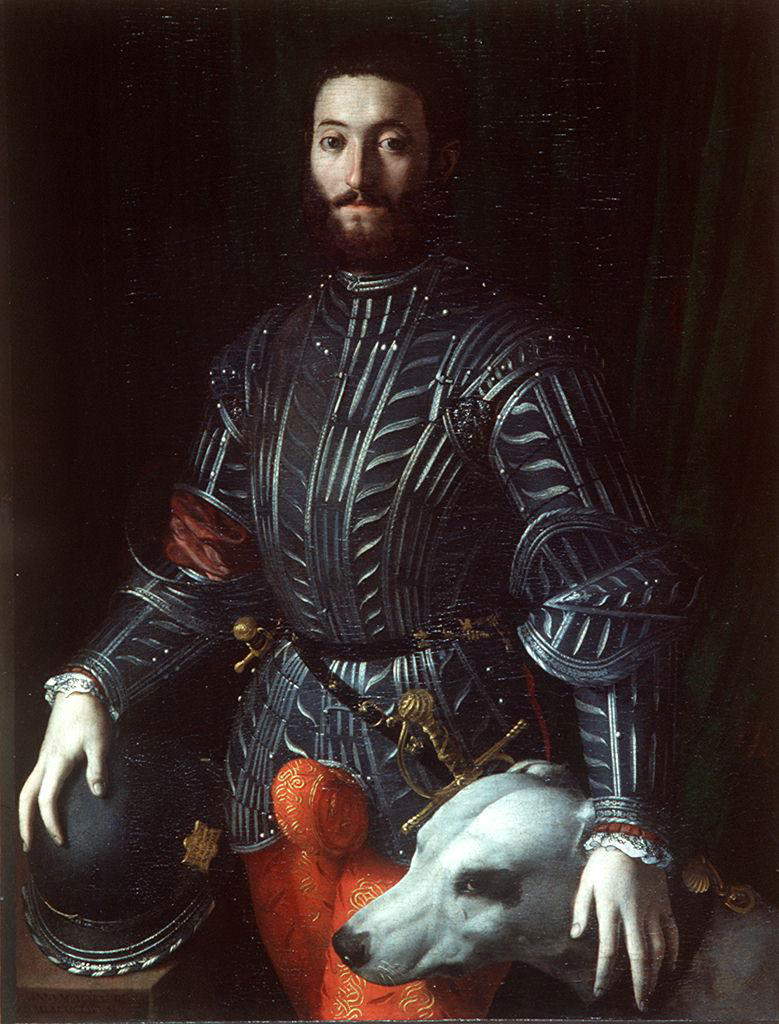
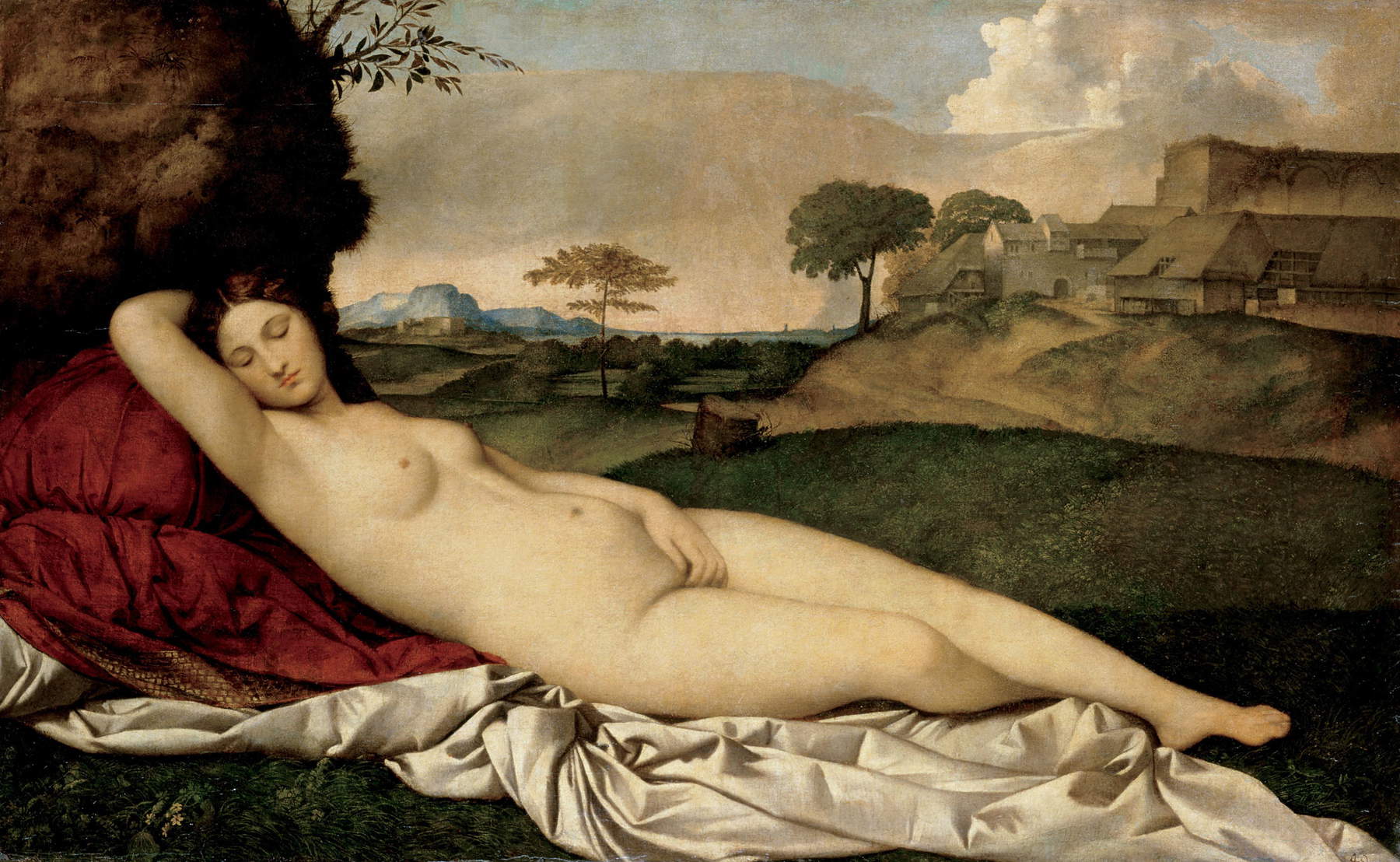
Yet, despite the fact that the matrimonial reading seems fitting, it is impossible not to feel some motion of perplexity in the face of this painting, which retains anambiguity that is difficult to shake, a reason why the reading of the meaning has not found unanimous acceptance among scholars. It has been mentioned how Shearman thought of Guidobaldo as the viewer of the painting, as the subject to whom Venus turns her gaze. How can this view be reconciled with the idea of a painting intended for the duke’s wife? Titian’s Venus is undoubtedly a racy and provocative goddess: how can such an overtly sensual attitude be considered to be addressed to a bride little more than a child, who was yet to be initiated into the pleasures of carnal love? There are thus unresolved knots, and ones that are never likely to be unraveled: however, an alternative reading could be proposed, starting with the motif of the goddess’ nudity. Before arriving at the elaboration of this painting of his that has now risen to the status of an icon in art history, Titian had had to reason at length about his model, Giorgione’s Venus: we find some variations on the theme of the reclining goddess in the Bacchanal of the Andrii of 1522-1524 and, a little later, between 1525 and 1530, in the Venus of the Leopard, a painting from his school now in the Louvre. The nudity of women had become, in early 16th-century Venetian painting, a kind of topos born in the groove of literature, where images of completely unveiled women were the first to spread: they range from Ludovico Ariosto’sOrlando furioso to theHypnerotomachia Polyphili via Iacopo Sannazaro’sArcadia in a web of continuous, often bidirectional cross-references between arts and letters. One could imagine the nudity of Venus as a simple expedient to kindle the duke’s desire: paintings of divinities without veils abounded in the homes of the nobles of the time and we can assume that often their only purpose was ’contemplative,’ as a letter that Pietro Aretino, in 1527, wrote to the duke of Mantua, Federico Gonzaga, about a work in progress suggests: “I believe that M. Iacopo Sansovino rarissimo will adorn your room with a Venus so true and so alive that it employs with lust the thought of each one who beholds it.” Similar considerations concerned Titian: in a letter written in 1544 to Cardinal Alessandro Farnese, Monsignor Giovanni della Casa, the celebrated author of Galateo, compared a then-unfinished Danae by Titian (it is the one now in the Museo Nazionale di Capodimonte, commissioned in all likelihood by the cardinal himself), and which he had seen in the master’s workshop, to the same Venus of Urbino, and told the cardinal that the latter, in comparison with the Danae, looked like a Theatine nun, and that the new work “would make the devil come down on Cardinal San Silvestro” (i.e., on the Dominican Tommaso Badiani who was known for his rigor and inflexibility). Moreover, the Danae was probably born after the patron saw the Venus of Urbino and asked Titian to paint him something similar: X-rays conducted on the Neapolitan work revealed an initial composition very close to the Uffizi picture. The educated public of the 16th century was thus fully aware of the erotic potential of works of art. Some paintings, such as Bernardino Licinio’s Nuda , a contemporary of the Venus of Urbino, would suggest that certain patrons ordered images of female nudes for the sheer sake of admiring a mulieval body without veils: Licinio’s Nuda does not even have mythological trappings that must provide further justification. A rare image, this one of Licinius, since more often than not artists drew from the mythological repertoire, but still not unique. The Venus of Urbino stands out from these images, however, for its unquestionable nuptial symbols, which nevertheless can be interpreted differently by looking at the context, and thinking about a certain concept of beauty proper to neo-Platonic philosophy that must not have been foreign to Titian, partly because it was widespread in the cultural circles of sixteenth-century Venice, and partly because the artist was a friend of Pietro Bembo, a poet and writer who was familiar with Florentine neo-Platonic thought.
The idea that Titian wanted to justify his image in a Ficinian sense, encapsulating in a single image the concept of love expressed by Marsilio Ficino, cannot perhaps be ruled out: according to the Tuscan philosopher, love(Amor) is the earthly manifestation of beauty(Pulchritudo) that moves directly from God and ends with pleasure (the Voluptas) that serves to procure that state of joy through which one can arrive at reunion with divinity, in a sort of spiritual circuit that goes from God to the world and vice versa. Venus, as the goddess presiding over love, beauty and the pleasures of love, could thus be understood as an image that sums up the characteristics of love according to Ficinian thought, and the accompanying attributes might not necessarily be understood as conjugal symbols, but simply as elements detailing the qualities of love (the rose alludes to constancy, the myrtle to joy, the pearl to the purity of the loving sentiment). The dog itself need not be read as a symbol of marital fidelity, not least because here, moreover, the animal cannot watch over, since it is drowsy: Arasse, for example, noted how the curvature of its back recalls the curve of Venus’s leg, suggesting “a much closer relationship with the body with which it shares the bed,” so much so that the dog, with its fur, might even condense “the representation of a fur that is too intimate to be shown.” However, even without wishing to push such a reading, one might recall that the dog, in antiquity, was also associated with lust: inAmor sacro e Amor profano, Titian’s masterpiece preserved at the Galleria Borghese, a dog that, in the background, gives a chase to a hare has sometimes been interpreted as a symbol of a predatory sexual instinct. And again, a dog also appears in the Prado’s Danae , a painting with which the theme of marital fidelity has nothing to do. The dog lying asleep and harmless at the feet of Venus could thus allude to love’s ability to subdue the most feral urges. It may be noted, however, that the dog in the Venus of Urbino is identical to the one that appears in the Portrait of Eleonora Gonzaga, a painting in which Titian, in 1532, depicted the wife of Francesco Maria I Della Rovere, father of Guidobaldo II. The animal may therefore have been functional, much more trivially, to offer the commissioner of the painting an additional element of familiarity in the setting, although it is not certain that what we observe is indeed the Della Rovere family dog: more simply, spaniels like the one painted in the Venus of Urbino were fashionable dogs at the time.
It would remain in this case to explain the presence of the two handmaids rummaging in the chest. Interesting, and at the same time daring, is in this sense the reading of the Japanese scholar Hidehiro Ikegami who, proposing to identify in the girl peeking into the chest a very young and inexperienced handmaid (the white of her dress would be a symbol of her innocence) and, in the one next to her, a more mature and aware maid, believes to read the three women appearing in the painting as an allegory of the three ages in relation to the theme of love: the young girl who looks out curiously at her first love experiences (hence the idea of sticking her head in the chest), Venus who instead represents maturity and awareness of this feeling, and finally the older maid who alludes to her later age, and the fact that she turns back to look in the chest could be, according to Ikegami, a sign that the woman is contemplating the time that has passed.
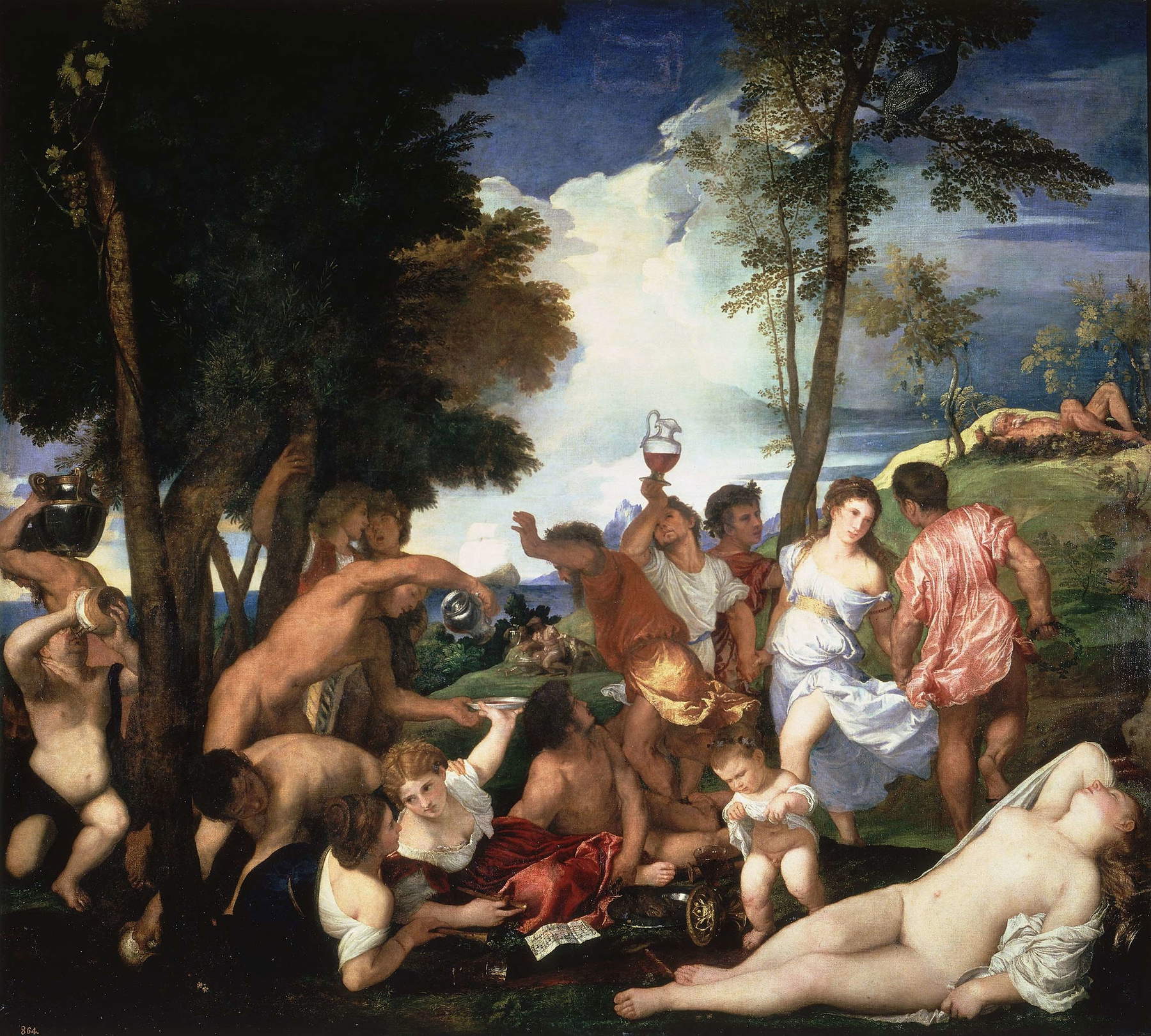
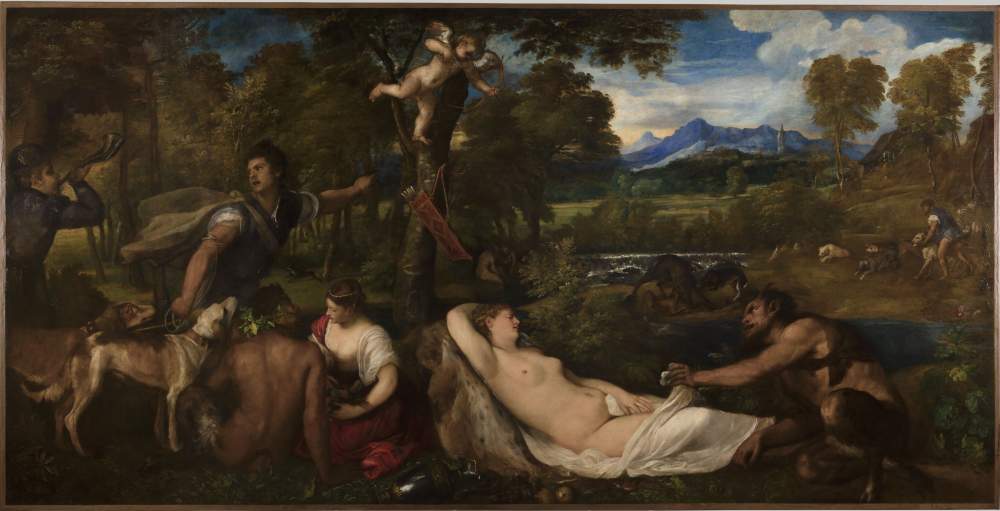
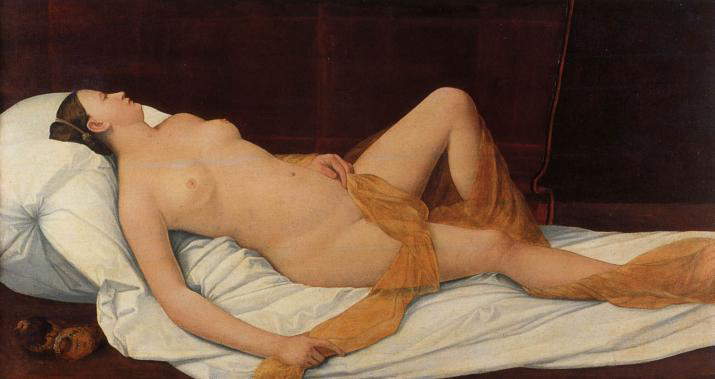
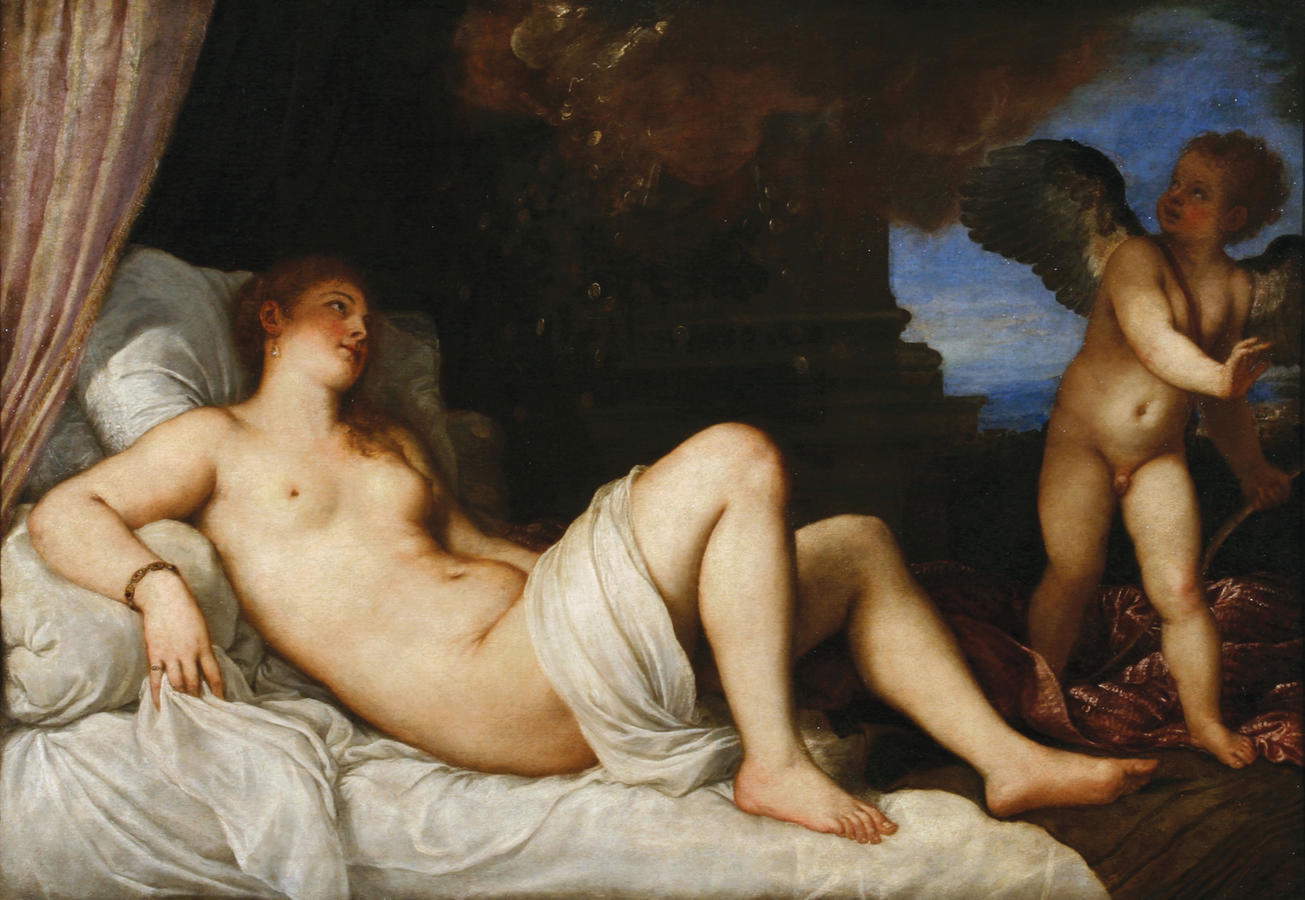
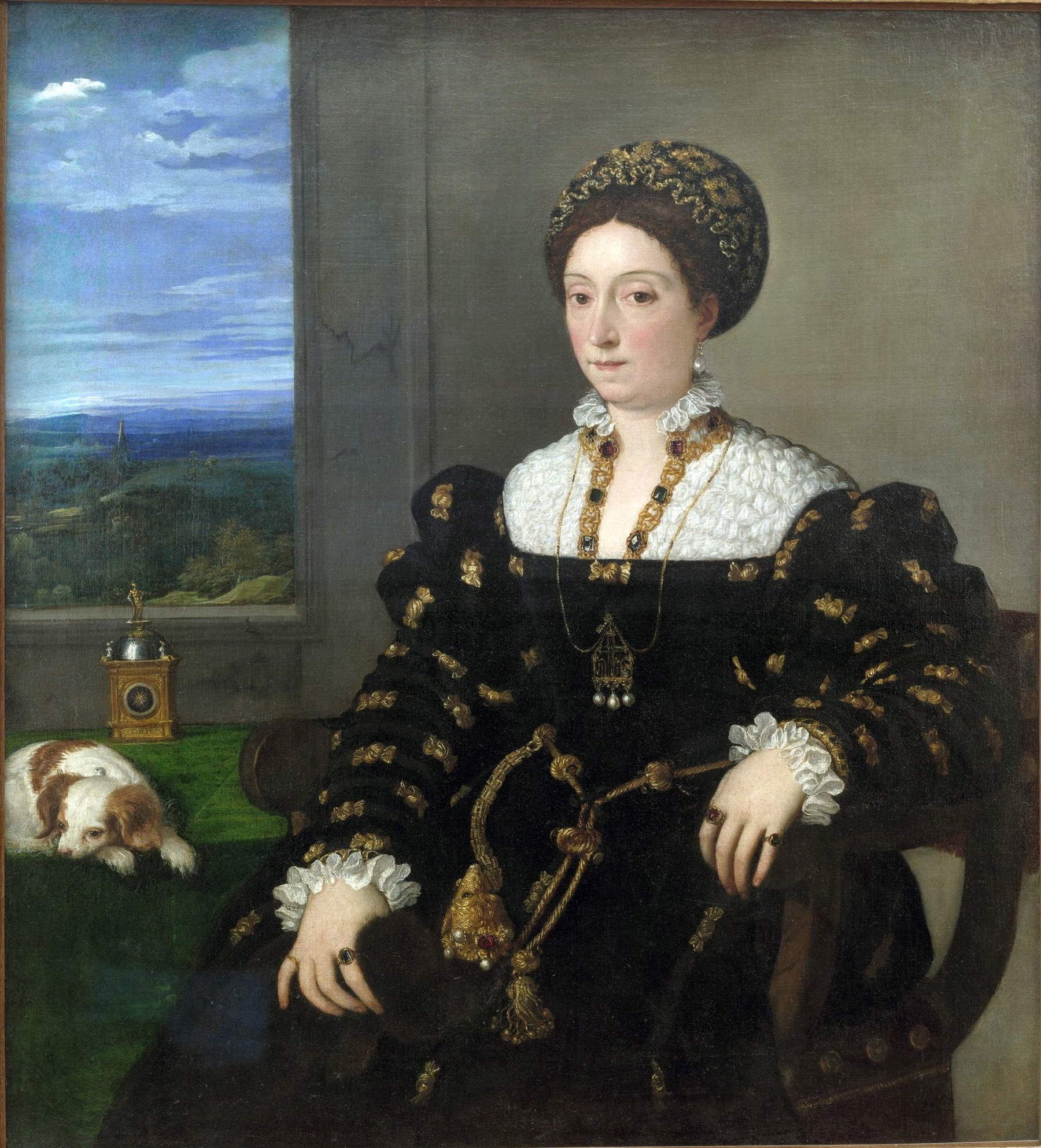
However, one may think that the meaning of the painting lies somewhere in between, so to speak: neither an educational painting aimed at the young bride, nor an erotic painting disguised as a celebration of platonic love. There are, for example, those who, like the scholar Andrea Beyer, have suggested the idea that the Venus of Urbino is rather a painting in which the goddess is summoned to play the role of pronuba in order to glorify an arranged marriage that neither bride nor groom wanted: a heartbreaking letter is preserved that Guidobaldo sent to his father, Francesco Maria Della Rovere, to ask his permission to marry the woman he was in love with (reciprocated), his contemporary Clarice Orsini, niece of Pope Julius II. The young man received a brutal denial in response: a marriage to that family was not considered worthy for the heir to a duchy, nor had Clarice’s mother, namely Felice della Rovere, the illegitimate daughter of Julius II, shown any interest in a possible marriage. Guidobaldo therefore had to resign himself to marrying the young daughter of the lords of Camerino. The same scholar, however, has urged us to consider that it would be wrong to attribute exclusively “innocent or domestic” meanings to paintings like the Venus of Urbino : the work has an undeniable erotic charge that nevertheless might not even steer the reading of the painting toward one meaning instead of another. More simply, we must imagine that Titian chose to deliberately spread around his masterpiece that aura of ambiguity mentioned above. There has long been speculation, for example, about theidentity of Venus: a woman who really existed? An occasional model? A courtesan? An ideal type? No one answer is more valid than another.
In any case, wide is the variety of readings that Titian’s women can warrant, and it is always the ambiguity of this extraordinary artist that makes such variety possible. “We can say,” Sylvia Ferino-Pagden has written, “that Titian created women and female types, drawing and ’equipping’ them according to diverse but precisely calculable interests: the variables to be brought into play were fundamentally beauty and implicit eroticism, perhaps enriched by a skillful interplay between detachment and availability, and by the continual tension between promise and abstinence, concession and denial, chaste refusal and hints of promiscuity. The artist was able to flesh out the full range of poetic discourses on love. Ambiguity was an element capable of particularly enhancing erotic appeal, and Titian made extensive use of it in this type of work.” It is for this reason that it is difficult to find one meaning that fits the painting better than another: instead, it is more likely that the levels of reading are multiple, that meanings go to intersect, that one hypothesis does not exclude another. And perhaps it is precisely in this sophisticated ambiguity that lies most of the fascination that the Venus of Urbino has exuded for centuries.
Warning: the translation into English of the original Italian article was created using automatic tools. We undertake to review all articles, but we do not guarantee the total absence of inaccuracies in the translation due to the program. You can find the original by clicking on the ITA button. If you find any mistake,please contact us.




























